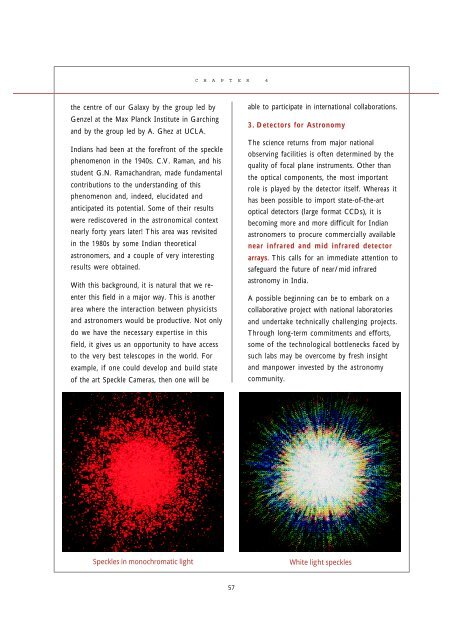2004 ASTRONOMY & ASTROPHYSICS - Indian Academy of Sciences
2004 ASTRONOMY & ASTROPHYSICS - Indian Academy of Sciences
2004 ASTRONOMY & ASTROPHYSICS - Indian Academy of Sciences
Create successful ePaper yourself
Turn your PDF publications into a flip-book with our unique Google optimized e-Paper software.
CHAPTER 4<br />
the centre <strong>of</strong> our Galaxy by the group led by<br />
Genzel at the Max Planck Institute in Garching<br />
and by the group led by A. Ghez at UCLA.<br />
<strong>Indian</strong>s had been at the forefront <strong>of</strong> the speckle<br />
phenomenon in the 1940s. C.V. Raman, and his<br />
student G.N. Ramachandran, made fundamental<br />
contributions to the understanding <strong>of</strong> this<br />
phenomenon and, indeed, elucidated and<br />
anticipated its potential. Some <strong>of</strong> their results<br />
were rediscovered in the astronomical context<br />
nearly forty years later! This area was revisited<br />
in the 1980s by some <strong>Indian</strong> theoretical<br />
astronomers, and a couple <strong>of</strong> very interesting<br />
results were obtained.<br />
With this background, it is natural that we reenter<br />
this field in a major way. This is another<br />
area where the interaction between physicists<br />
and astronomers would be productive. Not only<br />
do we have the necessary expertise in this<br />
field, it gives us an opportunity to have access<br />
to the very best telescopes in the world. For<br />
example, if one could develop and build state<br />
<strong>of</strong> the art Speckle Cameras, then one will be<br />
able to participate in international collaborations.<br />
3. Detectors for Astronomy<br />
The science returns from major national<br />
observing facilities is <strong>of</strong>ten determined by the<br />
quality <strong>of</strong> focal plane instruments. Other than<br />
the optical components, the most important<br />
role is played by the detector itself. Whereas it<br />
has been possible to import state-<strong>of</strong>-the-art<br />
optical detectors (large format CCDs), it is<br />
becoming more and more difficult for <strong>Indian</strong><br />
astronomers to procure commercially available<br />
near infrared and mid infrared detector<br />
arrays. This calls for an immediate attention to<br />
safeguard the future <strong>of</strong> near/mid infrared<br />
astronomy in India.<br />
A possible beginning can be to embark on a<br />
collaborative project with national laboratories<br />
and undertake technically challenging projects.<br />
Through long-term commitments and efforts,<br />
some <strong>of</strong> the technological bottlenecks faced by<br />
such labs may be overcome by fresh insight<br />
and manpower invested by the astronomy<br />
community.<br />
Speckles in monochromatic light<br />
White light speckles<br />
57
















